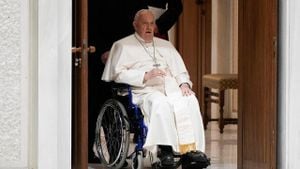Pope Francis’ health has become the recent focal point of discussion within the Vatican following his hospitalization last week, igniting speculation about his potential resignation. Cardinal Pietro Parolin, the Secretary of State for the Vatican, dismissed these rumors as "useless distorted ideas," urging attention instead on the Pope’s recovery and well-being.
Speaking to the Italian newspaper Il Messaggero, Parolin stated, "What we are considering now is the Pope's health, his recovery, and his return to the Vatican: these are the only important things." His comments come as concerns around misinformation and false reports have circulated amid the Pope’s hospitalization.
Responding to questions about the atmosphere surrounding Vatican rumors, Parolin remarked, "Honestly, I don’t know if there is such conspiracy, but I certainly try to keep myself out of it. On the other hand, it’s normal to see uncontrolled voices or inappropriate comments spread during such circumstances; this isn’t unprecedented. Nevertheless, I don’t think there’s any significant movement about the Pope's resignation at this moment." He emphasized the need for the Pope to focus on rest and rehabilitation, minimizing visitors to aid his recovery.
Adding to this narrative, Cardinal Víctor Manuel Fernández, head of the dicastery for doctrine, expressed similar sentiments. He indicated during his interview with Argentine newspaper La Nación about the absence of pressure from groups anticipating Pope Francis' resignation. "Certain groups believe it’s pointless to apply pressure. They have attempted this numerous times over the years, yet it’s only the Pope's entirely free decision, which is what counts," Fernández remarked.
Both Cardinals aim to convey their confidence in the Pope’s recovery, noting improvements reported from his time at Gemelli Hospital. Parolin shared positive updates from the hospital, indicating the Pope has been engaging with sent documents, which showcases his progress. Notably, they both stressed the importance of the Pope’s health reacting positively to treatment.
While concerns for the Pope's health remain at the forefront, the Vatican is also preparing for significant discussions at the upcoming international conference titled "The Temple and Artist: Reflections and Perspectives after 25 Years of the First Jubilee for Artists (2000-2025)." This conference, scheduled for February 13-14, will explore the relationship between the Church and the world of art and architecture.
The event reflects on how artists have responded to the Church's call for collaboration over the past 25 years, integrating the insights from the Second Vatican Council's liturgical reforms. The aim is to strengthen communication with artists and address the challenges of contemporary religious art and architecture.
Professor Ottavio Bucarelli, who is part of the organizing team from the Pontifical Gregorian University, explained the motivations behind the conference, stating, "This is a moment for reflection on the relationship between the Church and artists, the teachings of the Popes about art, and the realities we encounter during Mass." He noted it is significant to review how contemporary dynamics have influenced traditions and artistic expressions.
Adjustments made during liturgical celebrations post-Vatican II, such as changes to altar orientations, have transformed Church architecture. Bucarelli pointed out, "New Church designs must accommodate various altar setups. The challenge lies in finding harmony with historical structures, ensuring modern elements blend seamlessly with the ecclesiastical heritage. It should feel like a natural integration, not jarring to the congregation."
The conference will exemplify the need for collaboration among artists, architects, and clergy to revive the significance of religious art, which has historically faced challenges, especially with artists often unfamiliar with the demands of liturgically significant works.
Concluding remarks stress the importance of nurturing dialogues within these realms, advocating for guidance and comprehension between creators and the Church. This collaborative spirit aims at ensuring religious art evolves sustainably, respecting traditions whilst embracing innovative practices.



